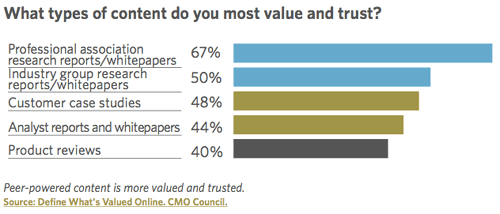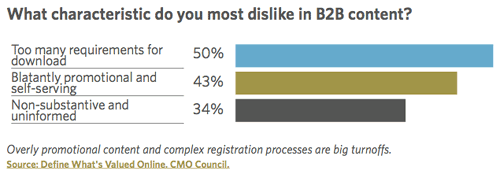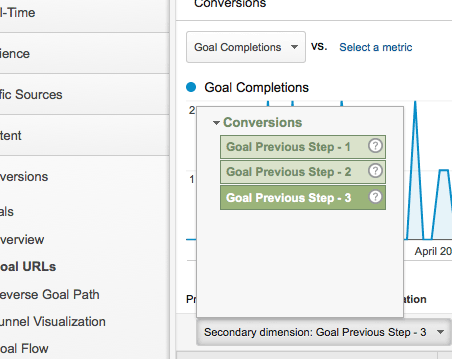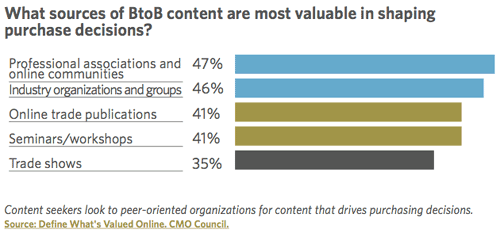B2B marketers are spending more than 25 percent of their budgets in the development, delivery and promotion of content, according to a recent survey run by the CMO Council and NetLine. Their objectives are to drive business leads, influence customer markets and grow brand presence and authority. More importantly, 87 percent of respondents indicated that online content has a moderate to major impact (67 percent and 20 percent respectively on what vendors they chose to work with.
While B2B sales and marketing groups appear to understand the need for better alignment through content marketing needs, strategic development is still in its infancy.
The survey report states that many organizations are engaged in “random acts of content development,” lacking cohesive strategy. This assessment is based on findings indicating that the B2B buyer is migrating to peer-based communities and trusted new sources. The B2B buyer finds that vendor sites fail in many ways, including navigation, depth, and accessibility.
SEO should be a significant component of the B2B content marketing mix; augmenting these efforts from concept to execution. Here are four ways B2B SEO professionals can better impact content marketing initiatives.
1. Better Content; Not More Content
As highlighted in recent coverage of the survey from eMarketer, quality trumps quantity significantly. “B2B executives have expectations for the content they consume, however, and seem disinterested in anything offering surface-level insights”.
Furthermore, the survey report indicated that blatantly self-serving and promotional content is a major turnoff, cited by 43 percent of respondents. Research and whitepapers based on professional association and industry input led the list of content assets B2B buyers valued and trusted most.

Keyword research should be at the forefront of any content development initiative. Not only are B2B marketers looking for keywords opportunities that have demonstrated traffic estimates, but also keyword themes that have shown to resonate with their target audience as well.
While Google’s Keyword Tool is a place to look for traffic estimates, keyword traffic reports based on conversion or other site performance metrics (like bounce rate, time on site, pages/visit, etc) are important for determining relevance to existing audience.

The above chart highlights keyword referrals for a client of ours, where we’ve defined multiple conversion goals. I’ve highlighted keyword ideas that have driven at least three of four conversion actions in a certain period of time. I would recommend exploring content marketing ideas based on these keyword themes first.
Additional places B2B SEO professionals should consider for evaluating keyword performance:
- Google AdWords and Bing Ads keyword reports
- Marketing automation prospect performance reports
- Internal search engine query reports
- Traditional customer service inquiries, software bug reports, feedback submissions, etc.
2. Develop a Lead Scoring System
The top turnoff from survey respondents was the level of requirements for download. While this factor must be acknowledged, alignment between sales readiness and vendor / industry research must also be balanced.
Not all inbound leads are equal and it is important that the B2B marketing team work with sales to determine proper criteria for pushing the lead directly to sales, or keeping the lead in the marketing database for further development.

I wrote about B2B lead scoring a while back that digs specifically into these concepts. The key for B2B SEO professionals is in aligning the requirements for conversion action with the content marketing asset’s perceived proximity to sales action.
The keyword chart in the previous point provides further example into how we might breakout conversion actions based on sales readiness. For our client, “Conv 4″ is a very high level lead, often associated with general information seekers. We track it because it is an easy way to obtain email information for newsletters and other company communications.
Our hypothesis is that a percentage of these leads ultimately convert to sales. We’re manually matching data right now and should have a marketing automation tool in place shortly to help take this over. As we connect the dots between conversion actions, we can better demonstrate the ROI in the creation of assets that support this conversion action.
3. Usability Matters, but B2B Marketers Need to FIND the Content First
While excessive form requirements might be an annoyance, content usability and accessibilitymatters as well. Ease of use and readability were the second most important characteristic B2B decision makers surveyed indicated (the top applicably being breadth and depth of information).
This brings into play two important SEO related initiatives.

- Cross-linking and navigational accessibility: SEO professionals need to evaluate site architecture in an effort to identify critical locations for cross-links and cross-promotion of content marketing assets. Besides manual review of site navigation and related content assets, look to analytics for assistance. Google Analytics has an easy to use navigational element to better understand the steps (web pages) converting visitors took before completing various goals on the website.
Joseph Kerschbaum wrote a more in-depth column on how to use Google Analytics visitors flow reports to improve conversion rates. It is definitely worth reviewing for more information and ideas.
- Device and technology usage: Forty-one percent of survey respondents used the smartphone and 30 percent used the tablet. As the percentage of users accessing content through a mobile device continues to increase, B2B marketers need to be sensitive to navigational limitations and conversion rates barriers mobile browsers create.
The simplest method for comparing user behavior by device type is in the main navigational stream (Google Analytics: Audience > Mobile > Overview) but B2B SEO professionals should also compare visitor performance by operating system, based on high performing keyword themes (Google Analytics: Traffic Sources > Search > Organic > Keyword – Secondary Dimension “Operating System”)
4. Build Inbound Links in the Right Places (Hint: It’s About Relationships)
While the right content and placement on the website is important, having avenues of outreach and distribution for content assets matters just as much.
As indicated in the survey, B2B decision-makers cited professional organizations and online communities as the most popular sources of information that would influence business and purchasing decisions.
Relationships and networks matter in getting exposure to content marketing assets developed.

B2B SEO professionals need to take this feedback into consideration when developing link building outreach initiatives; specifically finding target audiences and communities for link communication.
Places to consider for content distribution and network development:
Ways to identify industry influencers and communities:
- Interviews with PR agencies and marketing communications personnel
- FollowerWonk or Contaxio for analyzing Twitter followers
- Muck Rack and HARO for finding publication opportunities and journalists
- Speaker and sponsor lists associated to industry trade shows and conferences
Recent link building columns related to the information found in this report worth reviewing:
Final Thoughts
The CMO Council and NetLine report is available for download via short form submission here. I would recommend review, if for nothing else than to validate B2B search engine marketing initiatives proposed or to augment existing work.
How are your SEO efforts improving and assisting broader B2B content marketing initiatives? I would love to read your feedback and perspective via comments below.




